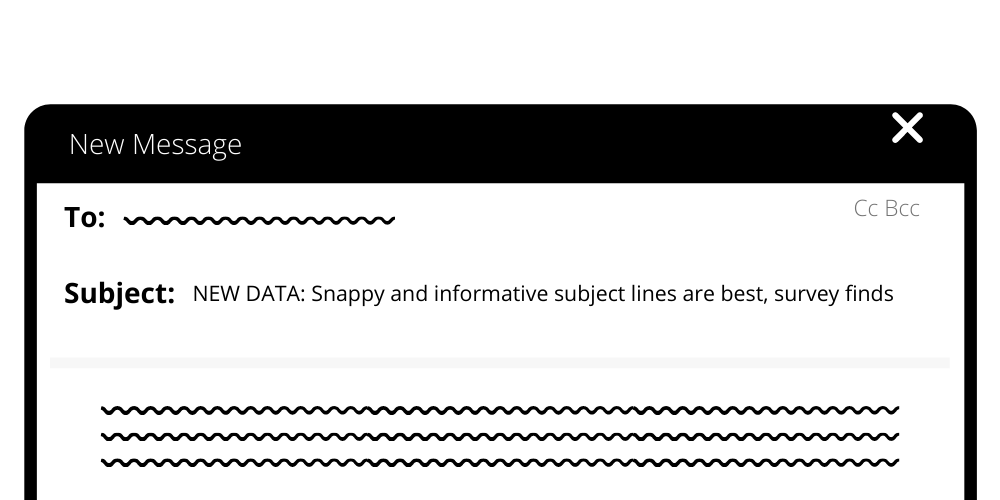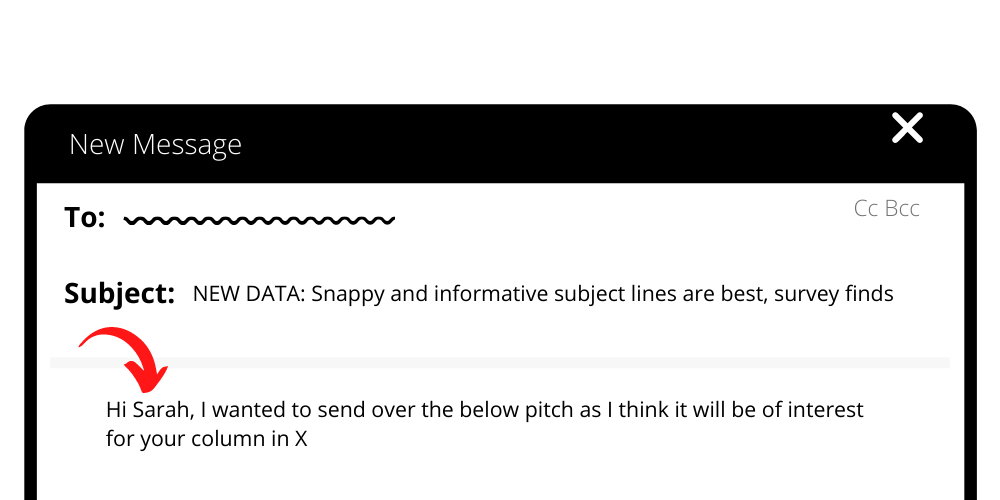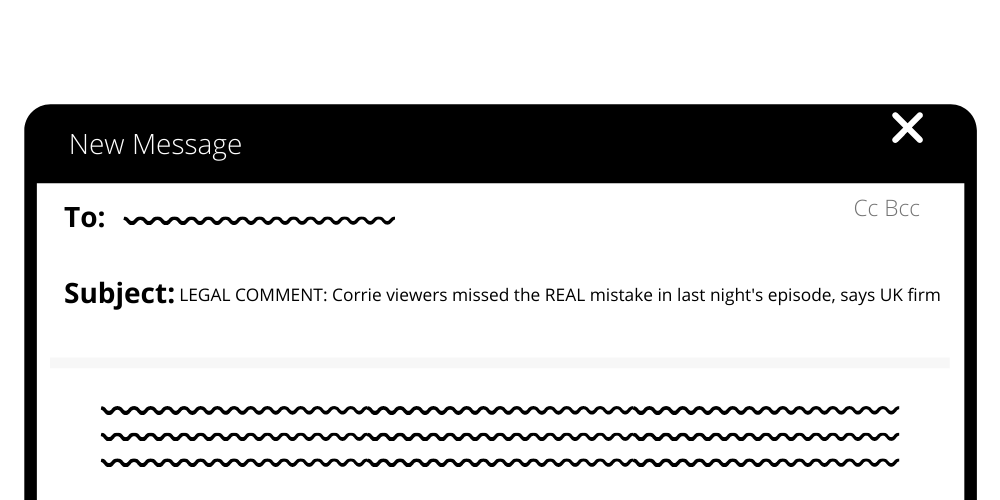Many PRs spend hours, weeks and even months putting their heart and soul into their latest content. However, great content can sometimes be let down by a poor pitch.
Pitching to a journalist shouldn’t be where your content strategy fails!
We have compiled a list of our top tried and tested tips that will increase both open and response rate and ultimately land coverage in your desired publications.
How To Improve Email Open Rate
- A clear subject line
- A summarised introduction
- Personalisation
- Reduce attachment size
How To Improve Email Response Rate
- Be direct with your request
- Conduct research before sending your email
- Ensure that you follow up
- Be clear
- Keep it short and sweet!
How To Improve Open Rate
Ensure your subject line is clear
Subject lines are CRUCIAL!
It’s really important to show a journalist that your email is relevant to them and their audience. Make this clear within your subject line by summarising your key points in one snappy sentence. It is also useful to state what kind of story you are pitching, whether it’s a case study or some new, juicy data.

Be sure to write your subject line in the style of the desired publication. Some publications, such as The Sun, like sensationalised headlines, whereas business publications for example, prefer the more professional angles.
Here are a few examples:
NEW DATA: 1 in 3 Brits won’t invite vegans to Christmas dinner, survey finds
RE: Garden furniture review – holiday at home this summer
See the Dog-tor: could prescription pups end lockdown loneliness?
It is nice to have punny and punchy subject lines, however, this is not always necessary. Sometimes being clear and straight to the point will do the trick.
Summarise! Summarise! Summarise!
Summarise your pitch within the first sentence of your email – and keep it short. Journalists are often strapped for time and can get hundreds of emails a day, so make their job a little easier for them.
Condensing a whole press release or email into one line can sometimes be tricky, so try to imagine that you are speaking to a friend and summarising a project that you are working on at work – this should help.
Personalise your emails
An oldie but goldie! Make each email personal to the recipient. It’s so easy to spot a mass-churned out email that doesn’t have any personalisation. Ensure your email has the target journalist’s name on it and potentially reference their publication or recent work that they have done which is relevant to your pitch.
For example…

Reduce attachment size
Be careful with attachments, as big documents within an email can get your message stuck in spam filters. If you need to send over additional content such as images, include a Dropbox link where the journalists can download these items themselves. You can also include a link to your website that has all the info the journalist needs, as this also gives them an incentive to link to your site.
How To Improve Response Rate
Being direct with your request
Be direct! Make sure that you ask direct questions.
Here are some examples of classic lines that can easily be converted to more direct questions:
“Let me know if you’re interested” and “Let me know what you think” can be easily converted to “What do you think?”
“Let me know as soon as possible” can be converted to “Please let me know by Friday at 4 pm”
As recommended in Martin, Goldstein and Cialdini in “The small BIG: small changes that spark big influence”, people are more encouraged to fulfil a request when they have engaged in some sort of commitment to it. This can be achieved by asking journalists a few extra specific questions about how they plan on fulfilling your request…something that requires more than a “yes” answer.
For example, try asking the journalist to let you know ‘what’, ‘how’ and ‘when’ they will publish the content from your press release.
Research is essential
PRs can sometimes fall into the trap of thinking the more contacts they send their pitch to, the better – but this simply isn’t the case. Do your research for your mailing list; the number one complaint that journalists have about PRs is that they send them irrelevant pitches.
A well thought out, targeted email will have a much better open and engagement rate than a blanket email that is spammed to the masses. If you want to improve your open rate and get journalists to engage with your content, then do your research.
We would recommend picking 10 publications you want to target and find the best contact at those publications.
Consider a few things:
- Who has recently written about the topic that your story relates to? This is key – if a journalist wrote an article about your topic a year ago and haven’t done a piece since then, find a better contact.
- The tone of voice. If your topic is broad, then there may be a few different journos that cover it, so pick a journalist whose tone of voice and style matches the content you’re sending out. For example, if your story teases about an error on a TV show, you may need a journalist that has a more satirical approach, or if your piece is about the latest must-have fashion item, then you’ll want to target a journo with more serious sartorial credentials.
Here are two examples that show how ample research before a release can really benefit the pitch.
Example one:
We recently sent out a brainteaser to just two journalists. This may seem like too small of a media list however, we had done our research and these contacts were extremely targeted. In the end, we got great coverage in 14 publications off the back of these targeted choices.
Example two:

The above press release worked well for us because the journalist we pitched to mainly writes about Coronation Street, so having ‘Corrie’ in the subject line was key here.
The timing of this pitch was also great: there was a big debate on social media and in the press about an incident that had happened on Coronation Street. We acted fast to get this release out, focusing on the fact that people were in fact concentrating on the wrong mishap and explaining the real issue from a legal standpoint.
This was great for our client as they could also show off their expertise in the field. A win-win.
Overall the piece gained 42 pieces of coverage including Express, Star, MSN and many regional publications.
Send a follow up email
If you’re not already sending follow-up emails then you are missing a trick! This is a simple way to gain a response. When you do follow up, try to put a twist on your initial email. Adding in a little extra info, or tying the story in with a topical event, gives you more of a reason to chase the journalist.
A general rule is to follow up the next week and then again if there are any updates in the story, so keep an eye on the news and recent trends for any reasons to follow up.
- Do you have a graphic that can be reformatted in other ways?
- Do you have hi-res images that you can send over?
- Do you have samples to offer? Use samples/gifts to your advantage here to reiterate that they are available, this will always catch the journalist’s eye.
Be clear
Make your intentions clear. If your number one target of your content campaign is to get links, then let the journalist know this in the pitch so they know what you’re expecting.
A simple “If you’d like to use this story, please credit this story with a link to [client website]” is enough to make your goals transparent.
This saves both you and the journalist time, as they know what you want before they take the story and prevents you from having to chase for links that the journo wasn’t aware they needed to include.
Keep it short and sweet
Journalists are short on time, remember. So giving your story a concise, succinct pitch demonstrates to the journalist that it has a clear angle and they can decide straight away whether they want it or not. If you can’t sum up your story in a short email pitch (less than 300 words) then it’s not ready to go out. Try sticking to 3-4 lines, or even better, bullet points to summarise the most important topics.
If you found this blog useful for improving your email response rate then head to our blog to check out more.

![[blog]_[Improve Email Response Rate: Small Changes That Make A Big Difference]_[Blog Picture]](https://cedarwood.digital/wp-content/uploads/2020/11/Untitled-design-75-900x506.png)
![[blog]_[6 Reasons Why Your Website NEEDS A Blog]_[Blog Picture]](https://cedarwood.digital/wp-content/uploads/2020/07/Untitled-design-51-900x506.png)
![[blog]_[Is Digital PR Valuable? And How Is It Measured?]_[Blog Picture]](https://cedarwood.digital/wp-content/uploads/2020/06/Untitled-design-76-900x506.png)
![[blog]_[Why are links important for SEO, and how can I get them?]_[Blog Picture]](https://cedarwood.digital/wp-content/uploads/2020/03/Untitled-design-57-900x506.png)